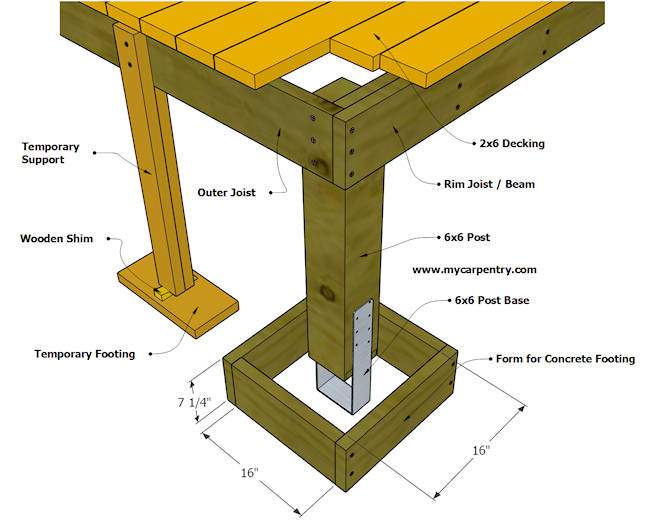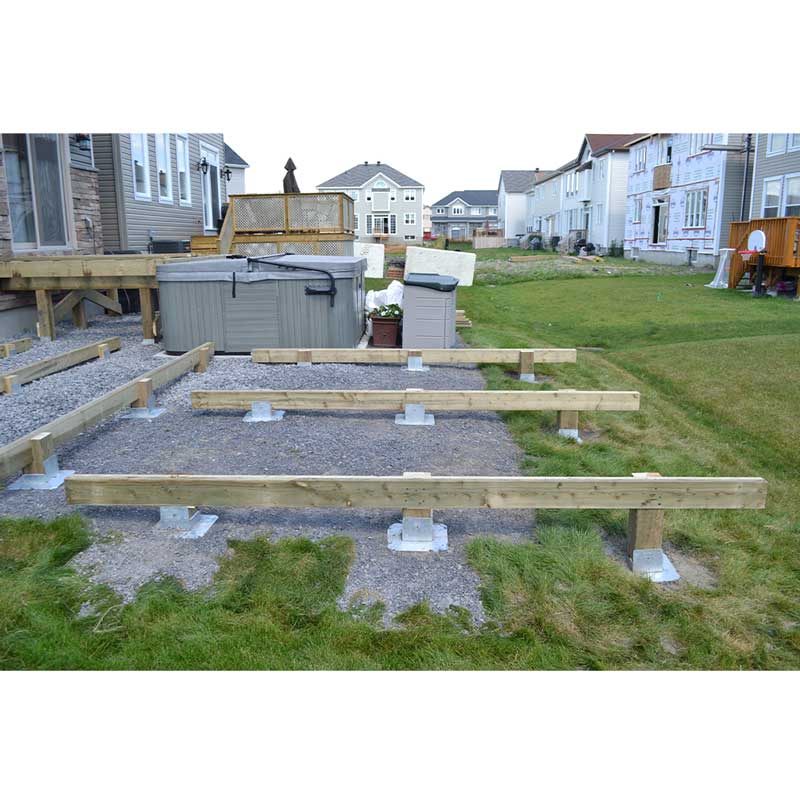Selecting the Right Deck Footings for Stability and Resilience
When it involves constructing a deck, among the most essential choices you will certainly make is selecting the best grounds for stability and resilience. The long life and safety and security of your deck depend greatly on the kind of grounds you select, as they give the necessary support and stability to withstand the test of time. With a myriad of alternatives available, it can be overwhelming to figure out which footings are best fit for your specific demands. In this discussion, we will discover the various kinds of deck footings, think about the crucial factors to evaluate when choosing, and explore the pros and disadvantages of different alternatives. By the end, you will have a clearer understanding of the selections at hand and be far better furnished to make an educated decision for your deck job.
Kinds Of Deck Footings
There are a number of sorts of deck footings that can be utilized, each offering one-of-a-kind advantages and considerations. One typical kind of footing is the concrete pier footing. These footings contain a cylindrical hole loaded with concrete, which offers a solid foundation for the deck articles. Concrete pier grounds are reasonably easy to install and provide exceptional security, making them a preferred selection for many deck projects.
An additional sort of ground is the helical pile footing. Helical heaps are steel shafts with helical plates connected to them. These grounds are mounted by screwing them right into the ground, which creates a safe and secure structure for the deck. Helical stack grounds are perfect for areas with difficult soil conditions, as they can be mounted in nearly any sort of dirt. They also permit for very easy modification and leveling of the deck if needed.
Alternatively, some contractors go with precast concrete grounds. These footings are made of long lasting concrete and be available in various forms and sizes to suit various deck designs. Precast concrete grounds are convenient to mount and offer a steady base for the deck structure.
Ultimately, one more alternative is the post-in-anchor footing system. This kind of footing involves driving a steel anchor right into the ground and attaching it to the deck article. It provides flexibility in terms of placing the deck articles and appropriates for decks with lightweight structures.
When selecting the ideal type of deck ground, it is important to take into consideration variables such as dirt conditions, deck tons, and neighborhood building ordinance (Deck Footings). Consulting with a professional specialist or architectural engineer can assist ensure the appropriate ground is picked for a safe and steady deck
Variables to Think About When Picking Footings
When choosing the proper footings for a deck, it is essential to carefully think about different variables such as soil conditions, deck lots, and adherence to local building ordinance. These elements play a substantial duty in ensuring the stability and longevity of the deck structure.
The kind of soil on which the deck will be constructed identifies the type of grounds called for. On the various other hand, decks developed on clay or extensive soils may call for grounds that can suit the soil's tendency to increase and agreement.
One more essential element is the deck load. The weight of the deck, consisting of the materials used and any kind of possible real-time tons such as furniture or events, need to be thought about when choosing grounds. The footings should be made to bear the weight of the deck and disperse it uniformly to stop any architectural concerns or failings.
Last but not least, adherence to regional building codes is critical. Building codes differ from region to region, and it is necessary to abide by the details needs set by the neighborhood authorities. Deck Footings. These codes make sure that the deck is developed securely and satisfies the essential requirements for structural stability and load-bearing capacity
Concrete Grounds: Benefits And Drawbacks

When utilized as the structure for a deck,Concrete footings use numerous benefits and negative aspects. On the silver lining, concrete grounds provide exceptional security and sturdiness. Concrete is a inflexible and solid material that can support heavy lots and endure numerous climate condition. It likewise has a long life expectancy, making it a dependable selection for long-lasting usage.
An additional benefit of concrete grounds is their adaptability. They can be put right into various sizes and shapes to accommodate different deck layouts and arrangements. Concrete footings can be customized to fit the specific demands and needs of the deck framework.
However, there are additionally some disadvantages to using concrete grounds. This can increase the total expense of the deck project and might need professional assistance.

Helical Piers Vs. Sonotubes: Which Is Much better?
In thinking about the foundation options for a deck, the contrast in between helical piers and sonotubes is crucial in establishing the visit this site remarkable option. They are turned into the ground making use of hydraulic equipment, providing a stable and resilient more tips here structure for the deck.
When it pertains to stability and resilience, helical piers have the upper hand. The helical plates on the piers develop a strong grip with the dirt, stopping any type of movement or shifting of the deck. This is particularly advantageous in areas with unsteady or shifting dirt conditions. Sonotubes, on the various other hand, depend only on the concrete filling up for security, which may not offer the very same level of toughness and resistance.
In regards to installation, helical piers are fairly easier and faster to set up contrasted to sonotubes. The hydraulic machinery utilized to turn the piers right into the ground guarantees a fast and efficient process. Sonotubes, on the other hand, call for excavating holes and putting concrete, which can be time-consuming and labor-intensive.
In addition, helical piers are an even more flexible alternative. If needed, they can be utilized in different dirt problems and can be readjusted or reinforced. Sonotubes, on the various other hand, might call for additional support, such as rebar, in specific soil problems or locations with high lots requirements.
Selecting the Right Footings for Your Deck's Dimensions
For ideal architectural honesty, it is necessary to carefully choose the suitable footings that line up with the measurements of your deck. The measurements of your deck, including its size, size, and elevation, play a significant role in identifying the type and size of footings needed.
When choosing footings index for your deck, it is necessary to take into consideration the load-bearing ability of the dirt. The weight of the deck, integrated with the weight of any type of furnishings or individuals on it, puts in a substantial pressure on the grounds (Deck Footings). It is crucial to choose footings that can sufficiently sustain this weight without sinking or moving over time.
Bigger decks with better measurements require larger grounds to supply adequate stability and support. The shape of the footings, whether they are round or square, depends on the style and layout of the deck.
Conclusion
Finally, choosing the appropriate deck footings is essential for making certain stability and resilience. Variables such as the kind of grounds, the deck's measurements, and the pros and cons of various alternatives ought to be considered. Concrete grounds provide toughness and durability, but may be a lot more costly and lengthy to install. Helical piers and sonotubes have their own advantages and disadvantages. Ultimately, selecting the suitable grounds for your deck's specific demands is crucial for a durable and successful framework.
These grounds are composed of a round opening loaded with concrete, which provides a solid foundation for the deck articles. Concrete pier grounds are reasonably very easy to mount and supply excellent stability, making them a popular option for many deck tasks.
Precast concrete grounds are practical to install and offer a steady base for the deck framework.
It supplies flexibility in terms of placing the deck messages and is ideal for decks with light-weight structures.
Concrete footings offer numerous benefits and negative aspects when made use of as the structure for a deck.